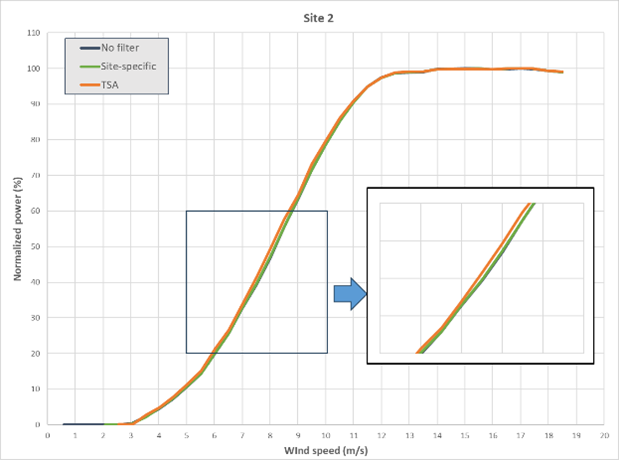The relevance of site-specific wind conditions on the Performance Warranty verification of wind turbines
Power Curve Verification tests, also known as Power Performance Verification, assess wind turbine performance under the actual wind conditions at the wind farm, rather than under standardized conditions. Therefore, it is crucial to accurately characterize these site-specific conditions during the wind resource assessment phase and ensure that they are properly reflected in the Power Curve Warranty defined in the Turbine Supply Agreement (TSA).
At Applus+, we occasionally observe discrepancies — beyond what can be attributed to seasonal variations — between the site-specific wind conditions measured during Power Curve Verification tests and those defined in the Power Curve Warranty. These warranty conditions usually take form of filtering criteria under which project-specific turbine performances are guaranteed. These discrepancies are frequently due to shortcomings in the wind resource measurement campaign or in the specification of filtering criteria within the TSA.
As a result, the difference in measured Annual Energy Production (AEP) with and without applying these contractual filters can exceed the assumptions used in energy yield assessments and financial models.
We illustrate this phenomenon with two typical examples, where contractual wind condition filters discard more than 50% of the datasets used in the performance warranty verification. By re-analyzing the site-specific conditions and defining site-specific filters, we significantly reduce the gap between the measured AEP under general wind conditions and under filter-compliant conditions.
Impact on measured power curves:


Impact on measured AEP:
|
|
|
Site 1 |
Site 2 |
|---|---|---|---|
|
TSA filters |
% of discarded datasets |
63% |
57% |
|
AEP difference when not applying filters |
- 1.91% |
- 2.06% |
|
|
Adjusted site-specific filters |
% of discarded datasets |
20% |
24% |
|
AEP difference when not applying filters |
- 0.51% |
- 0.15% |
This table highlights that applying the TSA-filters results in the rejection of approximately 60% of the data, significantly limiting the representativeness of the performance test. As a result, the measured AEP, as defined by the TSA, is about 2% higher than the expected AEP under actual site conditions, where turbines operate across the full range of local wind conditions. If the TSA-filters had been defined in accordance with site-specific conditions, this gap would be reduced to just 0.15%. This adjustment would make the performance test significantly more representative of the turbine behavior at the site and enhance the reliability of wind farm performance projections.
At Applus+, via our specialized Barlovento Applus+ teams, we have an extensive expertise in developing quality wind measurement campaigns, providing confidence during the energy yield assessment phase. We also support our clients in defining the site-specific conditions to be included in the TSA, ensuring controlled parameters that are suitable from a power performance warranty perspective. The purpose of these conditions is to verify the assumptions made about the turbine behavior during the long-term AEP assessment.
We also have worldwide expertise in conducting accredited power performance tests for warranty verification in a variety of conditions: from flat terrain to highly complex, onshore and offshore, including tropical and desertic, by means of met masts as well as LiDAR systems. Applus+ ILAC accreditation for conducting power performance tests, along with being a MEASNET member and an IECRE Testing Laboratory (RETL), and of course our extensive experience, makes us a major reference as Independent Tester for performing wind energy services.